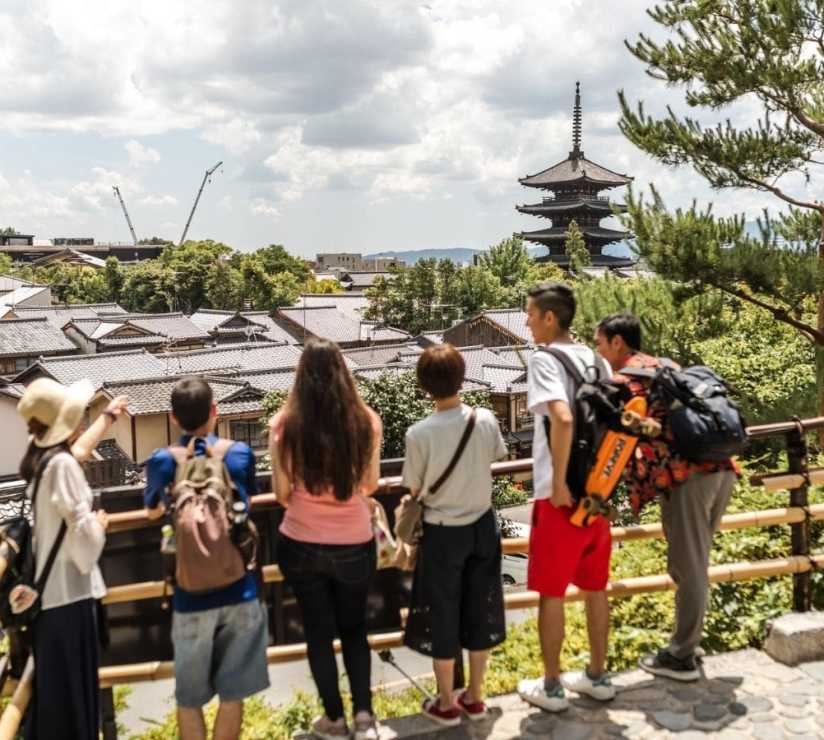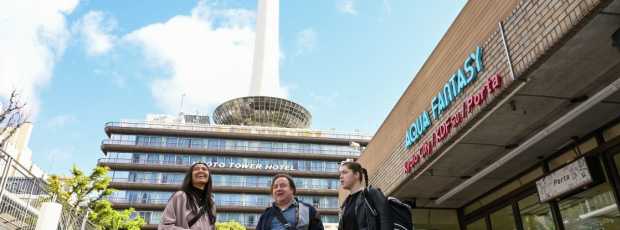Table Of Contents
- The logistics of your journey
- Diving deep with City Unscripted’s unique tours
- UNESCO treasures and City Unscripted’s exploration paths
- Iconic stops: Embracing Kyoto’s main attractions
- A gastronomic pause: Kyoto's culinary wonders
- Seasons and festivities: Kyoto’s dynamic cultural canvas
- Adaptable and personalized: Tailoring your journey
- Wrapping up: Setting forth on your Kyoto adventure

City Unscripted article image
Hey, I'm Ryo! Are you visiting Osaka and thinking about adding Kyoto to your bucket list? You absolutely should! Kyoto tours offers a compelling slice of Japan you won't want to miss, and Kyoto is just a short trip away. When I first explored Kyoto, I was just like you, looking for that authentic experience. With City Unscripted, you're not just sightseeing but diving deep into the local culture.
Why venture from Osaka to Kyoto? Imagine shifting gears from the vibrant hustle of Osaka to the serene beauty of Kyoto—all in under an hour. And the best part? It's not just about the destination; it's about the journey. Stay with me to discover how to make this experience as unforgettable as mine. You won't regret it!

City Unscripted article image
The logistics of your journey
Train rides and bullet trains
If you're in Osaka and eyeing a day trip to Kyoto, you're in for a treat. Getting from Osaka to Kyoto is so simple you'll wonder why you didn't plan this sooner! Your options are plentiful: a regular train ride will cost you just 560 yen (that's around five bucks) and takes 30 to 45 minutes. But if you're racing against the clock, hop aboard the Shinkansen from Kyoto Station; it's a 15-minute blur of scenery and costs about 1,420 yen (around $13).
Want a pro tip? Grab a prepaid IC card like Suica or Pasmo for a seamless journey. These cards work like magic on public transport, from local trains to the Shinkansen, and you can recharge them as you go.
Once you touch down in Kyoto, a City Unscripted tour guide is your best bet for diving deep into the city's marvels. Whether you're a history buff, a foodie, or just want to find those off-the-beaten-path spots, City Unscripted's Kyoto day tours make your day trip a tale worth telling.
Timely departures
You know that saying, "time waits for no one"? Well, in Japan, trains really don't wait! If the schedule says 10:03 AM, those doors close at 10:03 AM. So, plan to get to the station at least 10-15 minutes before your departure time for your day trip to Kyoto from Osaka. Especially if you're on a guided tour like a City Unscripted experience, you'll want that extra cushion of time to meet your tour guide at the designated drop-off or meeting point without breaking a sweat.
Early arrival means you can relax, maybe grab a quick snack, and ensure you don't miss out on any Kyoto adventures you've got lined up for the day. Missing a train in Japan doesn't just mess with your schedule; it can make you miss out on those one-of-a-kind experiences that make a day tour in Kyoto truly memorable.

City Unscripted article image
Diving deep with City Unscripted’s unique tours
One of the big perks of City Unscripted tours is customization. Whether you're into history, cuisine, or photography, your tour guide can adapt the day's itinerary to match your interests. This means you're not just stuck with a generic sightseeing loop; you could end up sampling local street food one moment and learning about the history of a less-known temple the next.
This customization really maximized my own Kyoto day trip experience, and it's something I'd highly recommend.
City Unscripted also goes beyond touristy spots, offering authentic experiences that get you closer to the local culture. Say goodbye to crowded attractions and hello to neighborhood gems only locals know about. Based on my experiences, this approach dodges the tourist crowds and makes your Kyoto visit much more meaningful. You'll leave with memories and stories that are uniquely yours.
Looking for a private city experience in Kyoto?
Explore the city with a local who plans a private day just for you; no groups, no scripts.

City Unscripted article image
UNESCO treasures and City Unscripted’s exploration paths
Kyoto is a treasure trove of UNESCO World Heritage Sites, and if you're into history and culture, you won't want to miss the Fushimi Inari Taisha Shrine. This is where you'll find thousands of red torii gates leading up Mount Inari. For first-timers, the hiking trail starts from the base and takes about 2-3 hours round trip. Another must-see is Kinkakuji Temple, also known as the Golden Pavilion Temple. Your best bet for visiting is early morning or late afternoon to dodge the crowds.
Pro tip: There's a small entrance fee to enter most of these sites—usually around 300 to 500 yen ($3 to $5).
Now, let's talk about making your exploration more effortless and more meaningful. City Unscripted offers guided tours that fill in all the background you'd miss on your own. For example, at Todaiji Temple, you'll see the massive Buddha statue and learn about its historical and cultural significance, like how it was constructed in the Nara period. And let's not forget Kiyomizu Dera Temple, known for its wooden terrace with panoramic views.

City Unscripted article image
Iconic stops: Embracing Kyoto’s main attractions
Golden wonders
Ah, the Golden Pavilion is a marvel you've got to see for yourself, but let me give you a preview. The two upper floors are covered in gold leaf and reflect onto a pond called Kyoko-chi (Mirror Pond), making it a photographer’s dream.
This Zen temple is always busy, so I advise you to go during the weekdays if possible and maybe avoid the lunchtime rush. The early mornings are incredibly tranquil.
Its stunning garden layout sets the Golden Pavilion apart from all other temples and is designed for strolling! As you walk, you'll discover little stone statues where you can try your luck by tossing coins. It’s said to bring good fortune! City Unscripted's tour guides really bring these kinds of details to life, sharing insights and local customs that you might otherwise miss. Pack some patience for the crowds and keep your camera at the ready; this is a spot you won't want to miss on your Kyoto day trip!
Gates to spirituality
Ah, the Fushimi Inari Shrine is a true masterpiece, and it's something you've got to experience firsthand. Situated just a short train ride from Kyoto Station, it's perfect for a day trip when you're visiting Kyoto from Osaka. I was floored when I first saw those vibrant vermilion torii gates. But it's not just a path of torii gates; each has a meaning.
The Torii gates are donations from businesses and individuals hoping for good luck or thanking for fortunes received. Inscriptions on the back of each gate identify the donors, and as you ascend, the gates start to thin out, offering serene spots to take in the cityscape.
Going on your own is cool, but if you want to elevate your visit, why not join a City Unscripted tour? They can arrange a guide who'll give you a deeper understanding of the shrine's historical significance dating back to the Heian period and its importance in Shinto beliefs. Knowing the why and how behind this incredible place changes the whole experience.
Nature's symphony
When visiting the Arashiyama Bamboo Grove, timing is vital. Early mornings are my favorite; you beat the crowds, and the light is magical. If you're not an early bird, consider going late afternoon to catch the sunset illuminating the famed bamboo grove and forest in a golden hue. Also, wear comfortable shoes, as you'll be walking on gravel paths that can be uneven in places.
Another helpful tip: The grove is just a 10-minute walk from the Saga-Arashiyama train station, making it super accessible.
While there's no entrance fee to tour the bamboo forest, nearby attractions like Tenryu-ji Temple have admission costs. And if you're looking to make the most of your visit to Kyoto, I highly recommend taking a day tour with City Unscripted. They can tailor your day to include Arashiyama Bamboo Grove and other hidden gems, and their tour guides are great at avoiding the touristy rush while giving you a deeper understanding of the place.

City Unscripted article image
A gastronomic pause: Kyoto's culinary wonders
Ah, the gastronomic landscape of Kyoto! I can't stress enough how the city is a feast for the senses, not just the eyes. Trust me, you'll want to carve out some time in your day tour from Osaka to Kyoto to indulge your taste buds. The traditional buffet lunches offer excellent value and are like mini-tours of Kyoto's culinary heritage—think tender sashimi, hearty tempura, and elegant Kyoto-style vegetables. I highly recommend places like "Yudofu Sagano," an important cultural property that's as aesthetically pleasing as its dishes.
If you're up for an even deeper dive into Kyoto's food scene, don't miss the street delicacies and fine dining options.
This is where City Unscripted really elevates your culinary adventure. Their tour guides aren't just knowledgeable; they're locals who are passionate about food! They'll take you to hidden gems and provide fascinating insights that you'd miss out on otherwise. So, next time you visit Kyoto during your Osaka Kyoto day trip, let City Unscripted make your lunch break an adventurous and enriching part of your tour.
What if your day in Kyoto was planned by someone who knows it — and you?
City Unscripted matches you with a local host who creates a private experience based on your interests, not a set route.

City Unscripted article image
Seasons and festivities: Kyoto’s dynamic cultural canvas
If you're in Kyoto for cherry blossom season, make sure to check the Sakura forecast in advance so you don't miss out on peak bloom.
And here's a tip: mornings are usually less crowded, so that's your window for some uninterrupted, magical Sakura moments. I recommend grabbing a bento box for a picnic under the cherry blossoms together—truly a local experience.
For festival enthusiasts, remember that each Kyoto festival has its unique attire and activities. For Gion Matsuri, wearing a Yukata (summer kimono) is culturally respectful and adds to the overall experience. If you're keen on trying out traditional Japanese dances and performing arts or crafts, look for festivals like the To-ji Flea Market, which often offers workshops. City Unscripted can help tailor a day trip for you to get the most out of these experiences. You'll want to check local schedules for dates and locations, as they can sometimes change from year to year.

City Unscripted article image
Adaptable and personalized: Tailoring your journey
Ah, the joy of a personalized journey—nothing compares, really. Let's face it: we all have our own pace and preferences when we visit Kyoto. You're in luck if you're short on time or have particular interests. City Unscripted specializes in catering to tight schedules and personal whims. Their day tours are so adaptable, they're like a choose-your-own-adventure book. Love temples but not so keen on shopping? Done. Only have half a day because it's a day trip from Osaka? No problem. Their tour guides work around you, not the other way around. I highly recommend them for a day tour that feels like it was crafted just for you.
When it comes to flexibility, City Unscripted's got your back. A last-minute change of plans? Their refund policies are super reasonable. What I adore is the customizable aspect of their tours. It gives you the assurance that your time in this magnificent city will be spent exactly how you want it. Your journey between Osaka and Kyoto can be as tight or as laid-back as you desire, and that's the beauty of it.

City Unscripted article image
Wrapping up: Setting forth on your Kyoto adventure
As your virtual Kyoto insider, let me tell you, the anticipation is as delightful as the journey itself! Whether it's your first or fifth time in this splendid city, you're in for a treat. Imagine standing among ethereal cherry blossoms or savoring a traditional buffet lunch, experiences that stick with you like the taste of sublime matcha. No spoilers, but "unforgettable" doesn't even begin to cover it.
Navigating Kyoto can be like learning to use chopsticks—tricky but totally worth it. That's where a bit of expertise comes in handy. If you want to cut through the overwhelm and see the city in a way that resonates with you, City Unscripted has got the right kind of mojo. Their guides are like those friendly locals you wish you had in every city. And as we part ways on this virtual journey, here's my closing note—have a super time in Kyoto! The city has so much to offer, and I can't wait for you to experience it.
Tip
We match you with the right host, not just any guide.Want to experience the real Kyoto with someone who lives there?
A fully private experience, planned and led by a local host who tailors the day to you
Ready to plan your perfect day in Kyoto?
Start your experienceWhat if your day in Kyoto was planned by someone who knows it — and you?
City Unscripted matches you with a local host who creates a private experience based on your interests, not a set route.
Want to experience the real Kyoto with someone who lives there?
A fully private experience, planned and led by a local host who tailors the day to you











